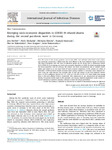Emerging socio-economic disparities in COVID-19-related deaths during the second pandemic wave in Germany
Hoebel, Jens
Michalski, Niels
Diercke, Michaela
Hamouda, Osamah
Wahrendorf, Morten
Dragano, Nico
Nowossadeck, Enno
Over the course of the second pandemic wave in late 2020, new infections with severe acute respira- tory syndrome coronavirus-2 shifted from the most affluent to the most deprived regions of Germany. This study investigated how this trend in infections played out for deaths due to coronavirus disease 2019 (COVID-19) by examining area-level socio-economic disparities in COVID-19-related mortality during the second pandemic wave in Germany. The analysis was based on nationwide data on notified deaths, which were linked to an area-based index of socio-economic deprivation. In the autumn and winter of 2020/2021, COVID-19-related deaths increased faster among residents in Germany’s more deprived dis- tricts. From late 2020 onwards, the mortality risks of men and women in the most deprived districts were 1.52 (95% confidence interval [CI] 1.27 −1.82] and 1.44 (95% CI 1.19 −1.73) times higher than among those in the most affluent districts, respectively, after adjustment for age, urbanization and population density. To promote health equity in the pandemic and beyond, deprived populations should receive in- creased attention in pandemic planning, infection control and disease prevention.
Dateien zu dieser Publikation

